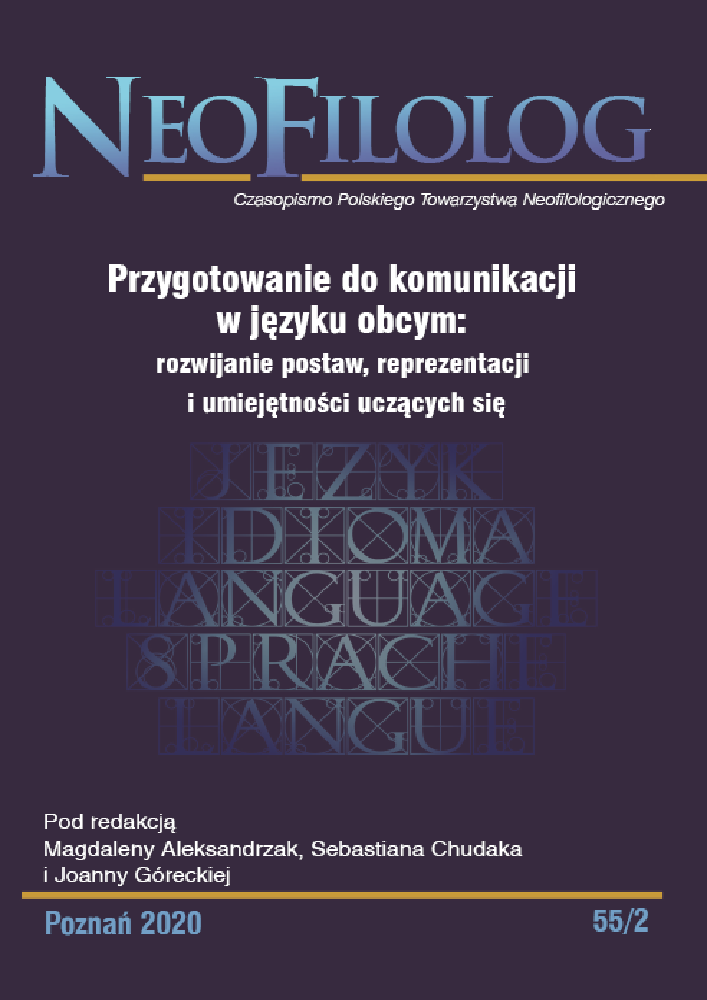Abstract
The aim of our article is to present a study of representations of the French language among Polish high school students. Given the small percentage of pupils learning French as Foreign Language (FFL) in Poland compared to the European average (33.17% of middle school students and 23.0% of high school students in Europe against 3.3% of middle school students and 10.8% of high school students in Poland (Eurydice 2017, GUS 2018), we wondered about the role that impressions relating to French can play in the choice or rejection of FFL by young Poles. Before presenting our research results relating to this problem, we give a brief description of the Polish sociolinguistic and educational context, then we approach the notion of representation / image of languages. Next, we move to the description of the methodological framework of the empirical study that we conducted with Polish-speaking high school students (learners and non-learners in FFL) before presenting the discussion of the results. On the one hand, we examined the impressions relating to French (defined as linguistic, aesthetic, cultural, social and political phenomenon), on the other representations relating to its usefulness.
Funding
French
References
Błaszkiewicz J. (2017), L’apprenant polonophone face à l’apprentissage d’une langue tertiaire : le français après l’anglais. (mémoire de maîtrise non publié, préparé sous la direction de Jolanta Sujecka-Zając). Varsovie : Université de Varsovie – Institut d’études romanes.
Castellotti V. (2017), Pour une didactique de l’appropriation. Paris : Didier.
Castellotti V., Moore D. (2002), Représentations sociales des langues et enseignements. Strasbourg : Conseil de l’Europe.
Chiffres clés de l’enseignement des langues à l’école en Europe. Rapport Eurydice. (2017), Luxembourg : Office des publications de l’Union européenne.
Dabène L. (1997), L’image des langues et leur apprentissage (w :) Matthey M. (red.), Les langues et leurs images. Neuchâtel : IRDP Editeur, s. 19-23.
Defays J.-M. (2018), Enseigner le français langue étrangère et seconde. Approche humaniste de la didactique des langues et des cultures. Bruxelles : MARDAGA Supérieur.
GUS (2018), Oświata i wychowanie w roku szkolnym 2017/2018, Warszawa/Gdańsk : Główny Urząd Statystyczny/Urząd Statystyczny w Gdańsku.
Jodelet D. (1993), Les représentations sociales. Regard sur la connaissance ordinaire (w :) « Sciences humaines » no 27, s. 22-24.
Ministerstwo Edukacji Narodowej (2016), Wstęp do rozporządzenia Ministra Edukacji Narodowej z dnia 17 czerwca 2016 r. zmieniającego rozporządzenie w sprawie podstawy programowej wychowania przedszkolnego oraz kształcenia ogólnego w poszczególnych typach szkół. Online :
https://men.gov.pl/wp-content/uploads/2016/11/podstawa-programowa-%E2%80%93-jezyk-obcy.pdf [consulté 09.02.2018] .
Moore D. (2001), Les représentations des langues et de leur apprentissage : itinéraires théoriques et trajets méthodologiques. (w :) Moore D. (red.) Représentations des langues et de leur apprentissage. Références, modèles, données, méthodes. Paris : Didier, s. 7-22.
Moscovici S. (1961/1976), La psychanalyse, son image et son public. Paris : PUF.
Pudo D. (2016), Représentations du français et d’autres langues étrangères chez les étudiants de philologie romane. (w :) « Romanica Cracoviensia » n° 4, s. 249–263. Online: http://www.ejournals.eu/Romanica-Cracoviensia/2016/Tom-16-Numer-4/art/8846/ [consulté 15.04.2020]
Semo M. (2018), Le français, cinquième langue la plus parlée dans le monde. « Le monde Afrique » du 11 octobre 2018. Online : https://www.lemonde.fr/afrique/article/2018/10/11/le-francais-cinquieme-langue-la-plus-parlee-dans-le-monde_5367799_3212.html [consulté 16.06.2019]
Zarate G. (1993), Représentations de l’étranger et didactique des langues, Paris : Didier.
Ziółkowski M. (2004), La francophonie en Pologne (w :) | « Hermès, La Revue » 2004/3 n° 40, s. 59-61. Online: https://www.cairn.info/revue-hermes-la-revue-2004-3-page-59.htm [consulté 15.04.2020].
License
Copyright (c) 2020 Radosław Kucharczyk, Krystyna Szymankiewicz

This work is licensed under a Creative Commons Attribution-NoDerivatives 4.0 International License.
Authors
Authors of texts accepted for publication in Neofilolog are required to complete, sign and return to the Editorial team’s office the Agreement for granting a royalty-free license to works with a commitment to grant a CC sub-license.
Under the agreement, the authors of the texts published in Neofilolog grant Adam Mickiewicz University in Poznań a non-exclusive, royalty-free license and authorize the use of Attribution-NoDerivatives 4.0 International (CC BY-ND 4.0) Creative Commons sub-license.
The authors retain the right to the free disposal of the work.
Users
Interested Internet users are entitled to use works that have been published in Neofilolog since 2017, under the following conditions:
▪ attribution – obligation to provide, together with the distributed work, information about the authorship, title, source (link to the original work, DOI) and the license itself.
▪ no derivatives – the work must be preserved in its original form. Without the author's consent, it is not possible to distribute the modified work in the form of translations, publications, etc.
Copyrights are reserved for all texts published since 2017.
Miscellaneous
Adam Mickiewicz University in Poznań retains the property right as a whole (layout, graphic form, title, cover design, logo etc.).

